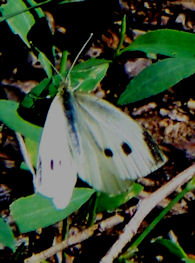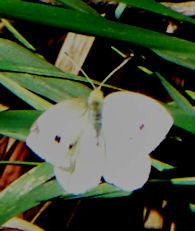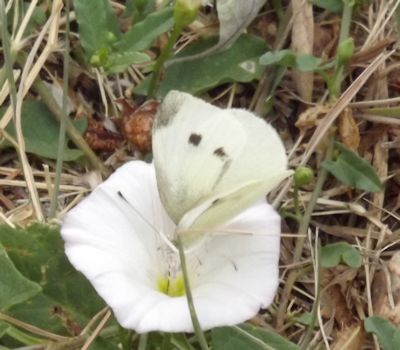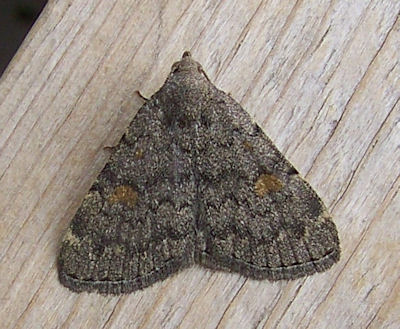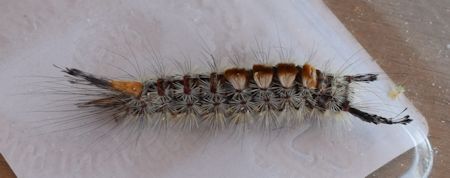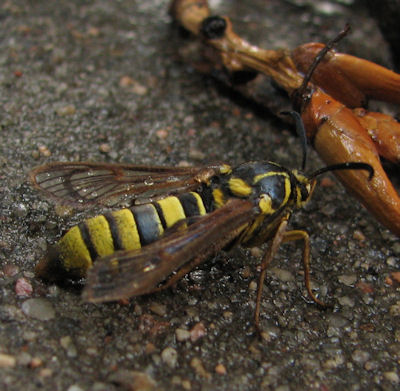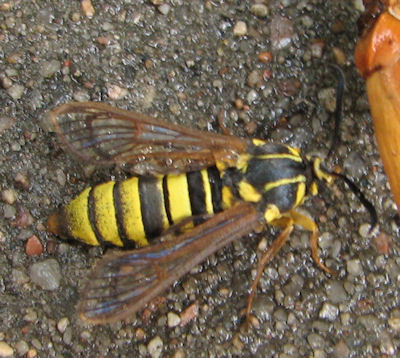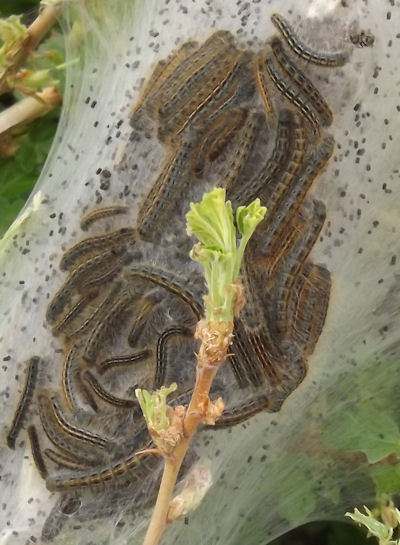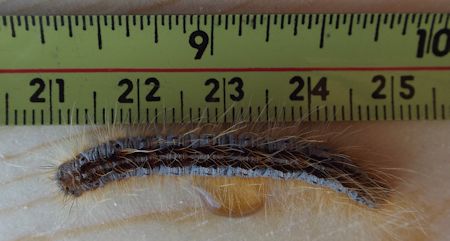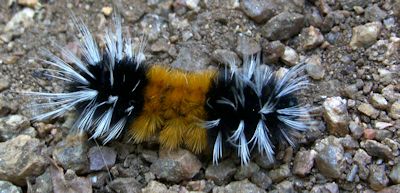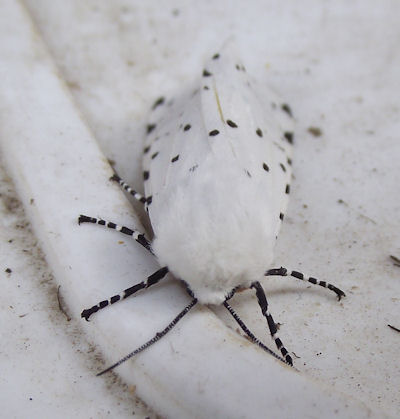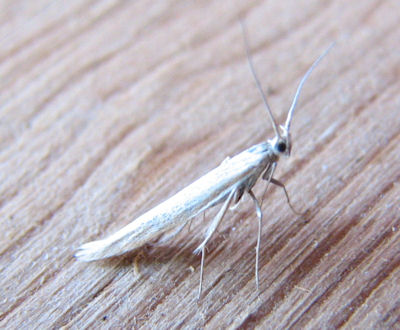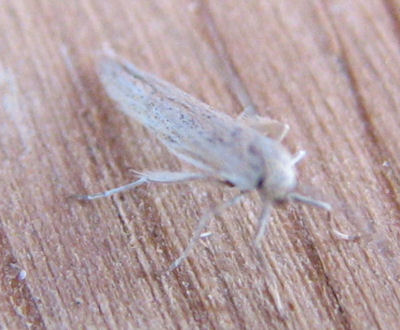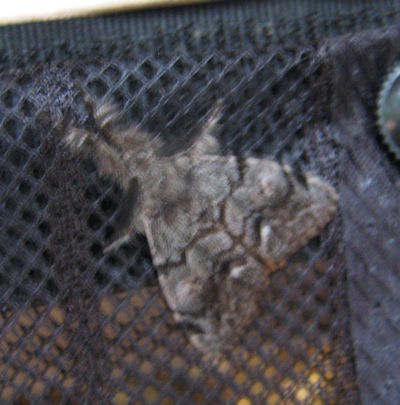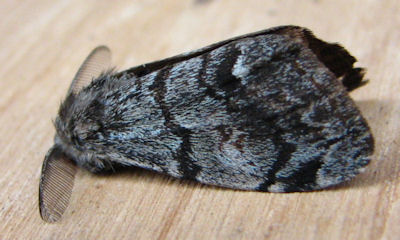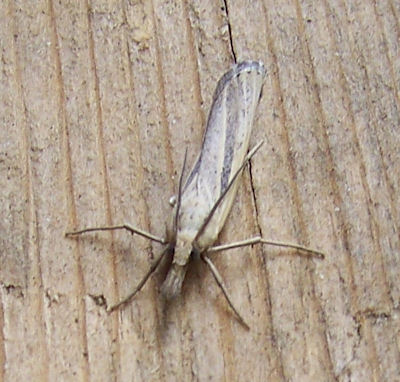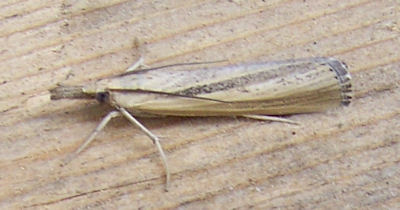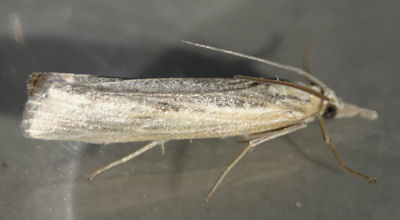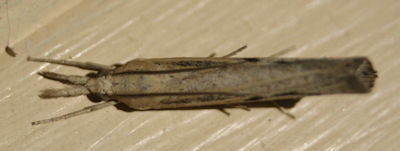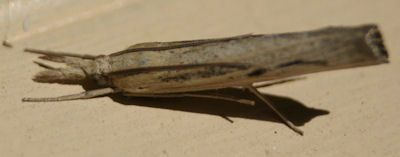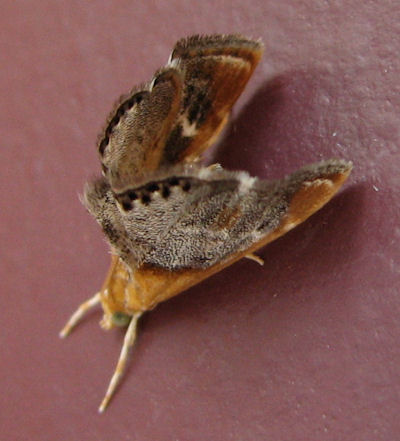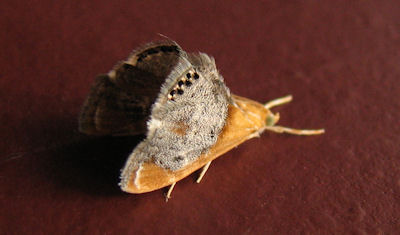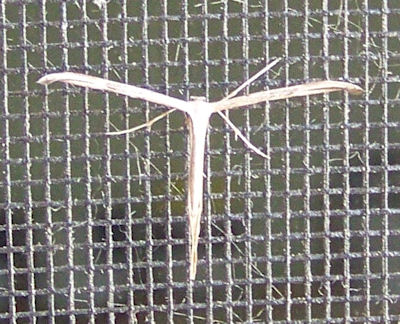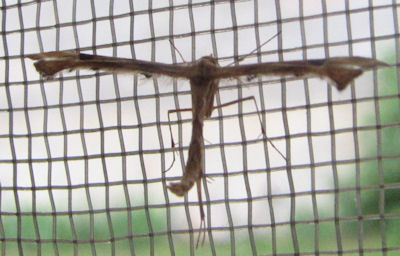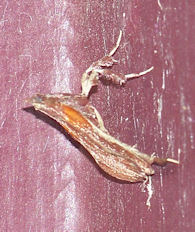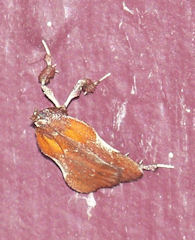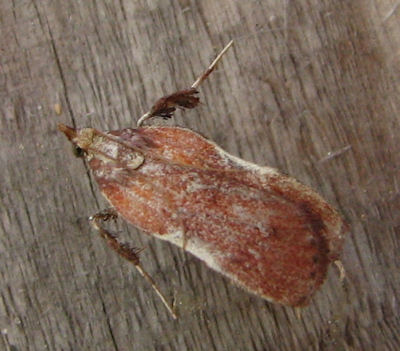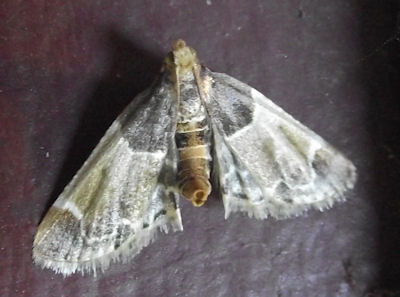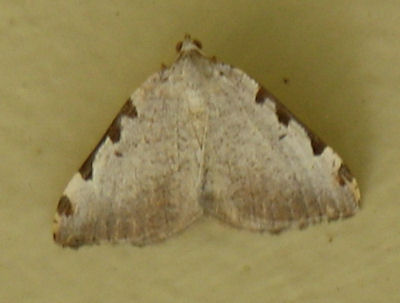| A Monarch Butterfly, 27 September 2008 at the Fountain Creek Nature Center.
In the fall, these butterflies migrate about 2,500 miles to Mexico to spend the winter hibernating. No other
insect can do this. Those from west of the Rockies do the same thing except to southern California.
The second picture is the Monarch caterpillar. The picture was taken on 23 August 2009, at the Fountain Creek
Nature Center. It was eating a leaf of a Milkweed plant, the favorite food for Monarchs.
The third picture was taken at the same place, but on 14 August 2011.
This one is only about 6mm long, quite young. It was on a Milkweed plant.
Kingdom: Animalia
Phylum: Arthropoda
Class: Insecta
Order: Lepidoptera
Superfamily: Papilionoidea
Family: Nymphalidae
Subfamily: Danainae
Tribe: Danaini
Genus: Danaus
Species: D. plexippus
| 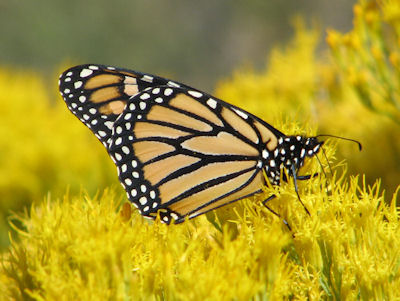
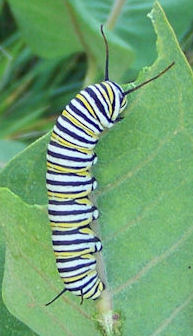
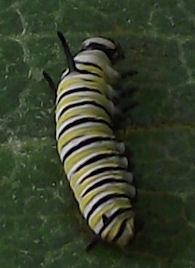
|
| Another Monarch Butterfly, July 3, 2016 at the Fountain Creek Nature Center.
| 
|
| A medium sized butterfly, seen on 12 October 2008 around my Marigold flowers.
This one is the Painted Lady, species Vanessa cardui.
Kingdom: Animalia
Phylum: Arthropoda
Class: Insecta
Order: Lepidoptera
(unranked): Rhopalocera
Superfamily: Papilionoidea
Family: Nymphalidae
Subfamily: Nymphalinae
Tribe: Nymphalini
Genus: Vanessa
Species: cardui
| 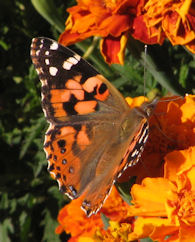
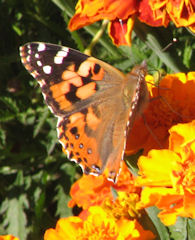
|
| This one, found on 3 July 2012 in Cripple Creek, Teller County, CO is another Painted Lady.
| 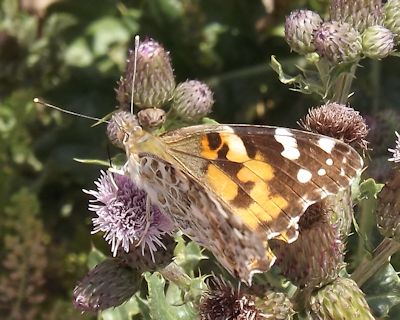
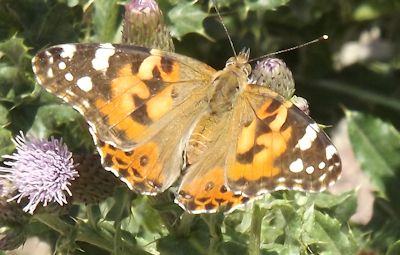
|
| Another Painted Lady, this one found near Cripple Creek, Colorado at more than 9,000 feet altitude. September 9, 2016.
| 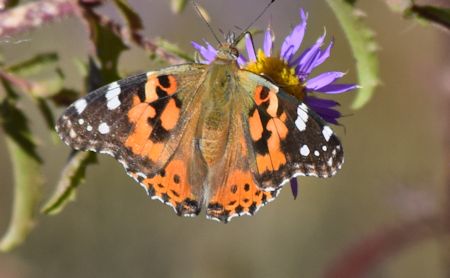
|
| A large number of these have visited my Marigold patch on the 1st and 2nd of October, 2017.
They must be on a migration, and arrive here in early October.
| 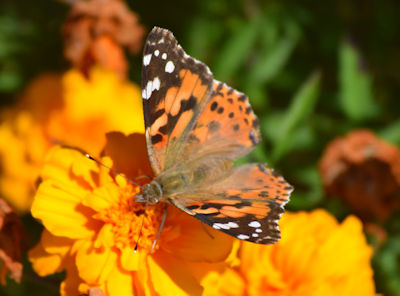
|
| Another butterfly in the Vanessa genus, this one the
Red Admiral, Vanessa atalanta. This one was found on 26 June 2009 at the Fountain Creek Nature Center,
feeding on a Milkweed plant.
The second picture was taken in the same place, but on 26 July 2010.
| 
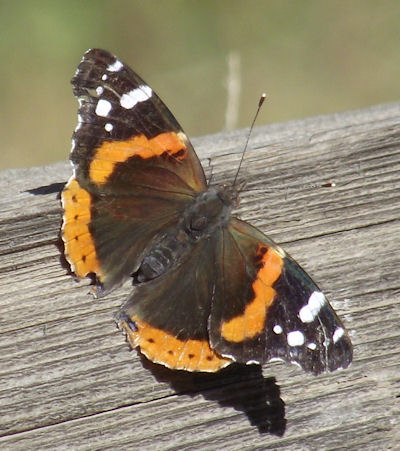
|
| This is a Queen butterfly, and is often found on milkweek plants. This one
was photographed on 4 July 2010 at the Fountain Creek Nature Center in Fountain, Colorado.
Kingdom: Animalia
Phylum: Arthropoda
Class: Insecta
Order: Lepidoptera
Family: Nymphalidae
Subfamily: Danainae
Tribe: Danaini
Genus: Danaus
Species: D. gilippus
| 
|
| This is a Mourning Cloak butterfly, photo taken
by Alyssa Erickson in June 2009. It looks a little beaten up.
The second and third photos show the caterpillar stage of this butterfly.
It is a fairly large caterpillar, about 1 3/4" long. It is sometimes known as a
Spiney Elm caterpillar. It was found on 27 June 2009 on the back of my
house in Colorado Springs, CO.
Kingdom: Animalia
Phylum: Arthropoda
Class: Insecta
Order: Lepidoptera
Family: Nymphalidae
Tribe: Nymphalini
Genus: Nymphalis
Species: N. antiopa
| 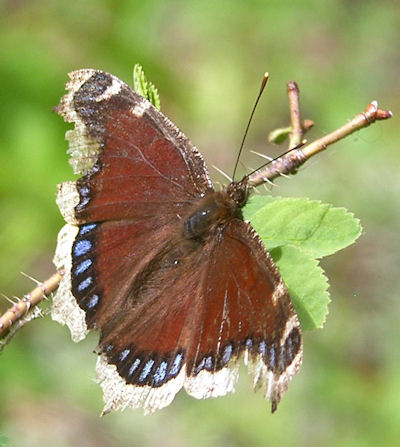
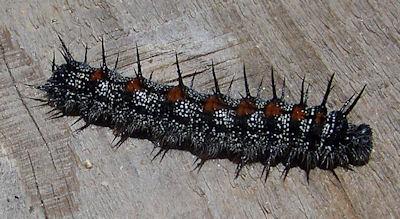

|
| Another Mourning Cloak butterfly, photo taken
at Skaguay Reservoir, Teller Co., CO 14 June 2012.
| 
|
| This one was found near Brush Hollow reservoir, in Fremont County, CO.
on 17 June 2010.
It is a medium sized butterfly, and seemed to prefer Canadian Thistles.
It is a Variegated Fritillary, and lives in both North and South America.
Kingdom: Animalia
Phylum: Arthropoda
Class: Insecta
Order: Lepidoptera
Family: Nymphalidae
Subfamily: Heliconiinae
Genus: Euptoieta
Species: E. claudia
| 

|
| Another one, this one was found at Skaguay Reservoir,
Teller County, Colorado, on 14 June 2012.
| 
|
| This small butterfly was seen on 31 May 2011 in the mountains near Cripple
Creek, Teller county Colorado.
It looks to be a close match to the butterfly above, but not quite.
This one is a Pearl Crescent, same family as above, but different genus.
This one is a male.
Kingdom: Animalia
Division: Rhopalocera
Phylum: Arthropoda
Class: Insecta
Order: Lepidoptera
Family: Nymphalidae
Genus: Phyciodes
Species: P. tharos
| 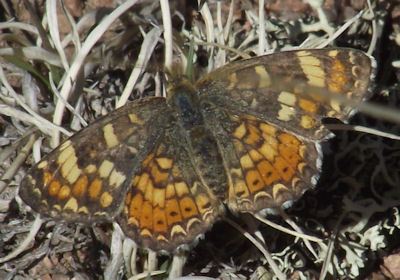
|
| This one is a Weidemeyer's Admiral (Limenitis weidemeyerii).
It was photographed on 31 July 2010 at the Fountain Creek Nature Center. It is found in
western Canada and western USA.
Kingdom: Animalia
Phylum: Arthropoda
Class: Insecta
Order: Lepidoptera
Superfamily: Papilionoidea
Family: Nymphalidae
Subfamily: Nymphalinae
Genus: Limenitis
Species: L. weidemeyeri
| 
|
| A Western Tiger Swallowtail butterfly, photographed on 28 June 2009 at the Fountain
Creek Nature Center, Fountain Colorado.
But when I look at pictures of the Eastern Tiger Swallowtail butterfly, I find that I can not
tell the difference. So, this might be a Papilio glaucus. The Rocky Mountains are usually considered
the dividing line, so it could be either one.
An expert on bugguide.net says that
along the front range, Pueblo to Denver, the most common is the Two-tailed Swallowtail,
which also looks similar. He also says that in Colorado Springs, we could also see the Pale Tiger
Swallowtail, so there are four possiblities.
Kingdom: Animalia
Phylum: Arthropoda
Class: Insecta
Order: Lepidoptera
Family: Papilionidae
Genus: Papilio
Species: P. rutulus
| 
|
| This one was found at Skaguay reservoir, Teller county Colorado,
on 1 July 2011. It is either a Western Tiger Swallowtail butterfly, or an Eastern Tiger
Swallowtail, or a Two-tailed Tiger Swallowtail. The more I study pictures of them,
the more convinced I become that I don't know which they are.
| 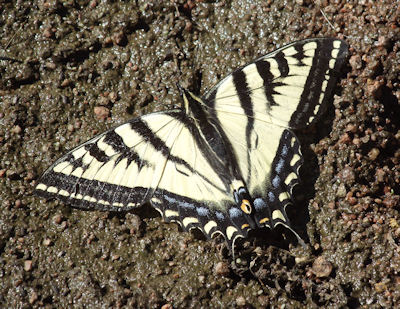
|
| More of them, at Skaguay reservoir, Teller county Colorado,
on 14 June 2012. These (and the one from a year ago, same place) match the pictures of
a Western Tiger Swallowtail butterfly better then the other close relatives. They tended to hang
around in bunches.
| 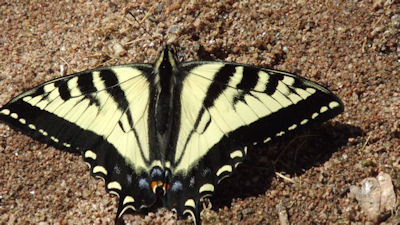

|
| A Black Swallowtail butterfly. Picture taken on 19 August 2009
at the Fountain Creek Nature Center. The second picture is of another individual, taken
on 7 October 2009 in Colorado Springs on my Marigold flowers.
Kingdom: Animalia
Phylum: Arthropoda
Class: Insecta
Order: Lepidoptera
Family: Papilionidae
Tribe: Papilionini
Genus: Papilio
Species: P. polyxenes
| 

|
| This butterfly was found at Skaguay Reservoir, Teller Co., CO on 14 June 2012.
It was not more than 1 cm body length.
Identification was made by the experts on
www.BugGuide.com.
Kingdom: Animalia
Phylum: Arthropoda
Class: Insecta
Order: Lepidoptera
Family: Hesperiidae
Subfamily: Pyrginae
Tribe: Pyrgini
Genus: Erynnis (Duskywing butterflies)
Species: telemachus
| 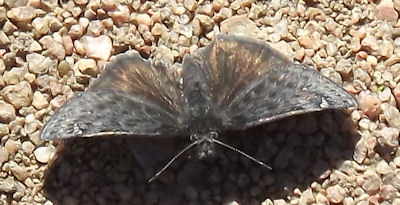
|
| An expert on www.Bugguide.net said this is one of the checkered-skippers. Found 11 July 2012 in Colorado Springs. Two individuals,
the largest about 1.5 cm in body length.
Kingdom: Animalia
Phylum: Arthropoda
Class: Insecta
Order: Lepidoptera
Family: Hesperiidae (skipper)
Genus: Pyrgus
| 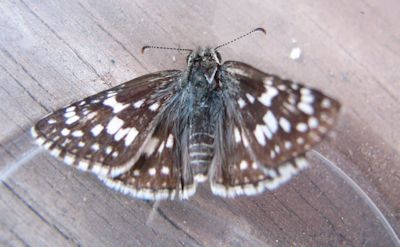
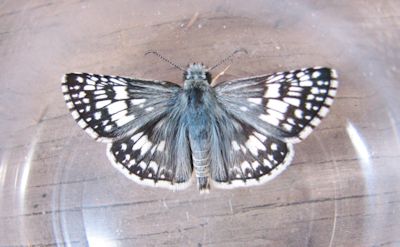
|
| This is a Common Checkered Checkered Skipper, Pyrgus communis, found on August 16, 2016 in Colorado Springs.
The identification is by the experts at Bugguide.net. Body length is about 1.5 cm.
Kingdom: Animalia
Phylum: Arthropoda
Class: Insecta
Order: Lepidoptera
Family: Hesperiidae (skipper)
Genus: Pyrgus
Species: communis (Common Checkered Skipper)
| 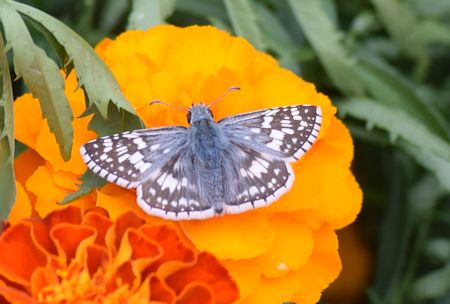
|
| This is another one of the Skippers.
It was identified by Andrew McKorney on www.BugGuide.net.
as a Taxiles Skipper, probably a male.
It was found in Colorado Springs on 18 July 2014. It is sitting on the edge of a 1x6 cedar board, so
the body length is about 3/4".
Kingdom: Animalia
Phylum: Arthropoda
Class: Insecta
Order: Lepidoptera
Family: Hesperiidae (skippers)
Genus: Poanes
Species: Taxiles
| 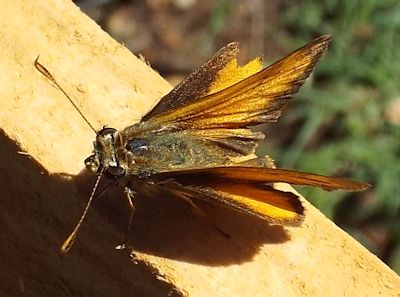
|
| This is a Silver-spotted skipper.
It was photographed on June 29, 2016 at the Fountain Creek Nature Center, Fountain Colorado.
Kingdom: Animalia
Phylum: Arthropoda
Class: Insecta
Order: Lepidoptera
Family: Hesperiidae
Tribe: Eudamini
Genus: Epargyreus
Species: E. clarus
| 
|
| Another Skipper, photographed on
August 18, 2016 in Colorado Springs, CO. It was enjoying my Marigold flowers. This one is a female.
Identification was provided by the experts at www.Bugguide.net.
Kingdom: Animalia
Phylum: Arthropoda
Class: Insecta
Order: Lepidoptera
Familia: Hesperiidae (Skippers)
Subfamilia: Hesperiinae
Tribus: Hesperiini
Genus: Atalopedes
Species: campestris
| 
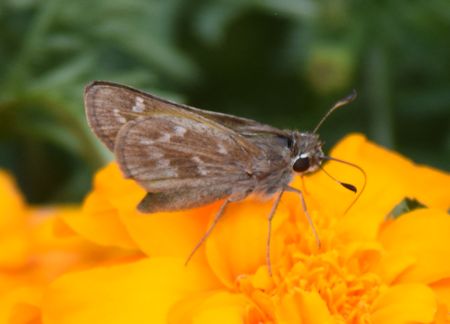
|
| Another Skipper, photographed on
September 18, 2016 in Colorado Springs, CO. It was also enjoying my Marigold flowers.
The outside of the wings matches the previous Skipper nicely, but the inside of the wings don't match.
I'm assuming that it is still the same species.
| 
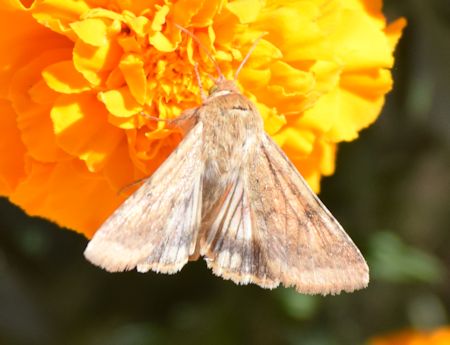
|
| This is a White-lined Sphinx Moth (Hyles Lineata) and is
also called the Hawk Moth and the Hummingbird Moth. It is approximately 5 cm in body length.
It was found in Colorado Springs on 12 August 2010.
Kingdom: Animalia
Phylum: Arthropoda
Class: Insecta
Order: Lepidoptera
Family: Sphingidae
Genus: Hyles
Species: H. lineata
| 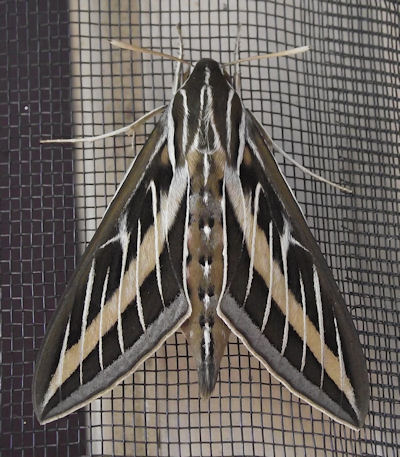
|
| Another one, found in Colorado Springs
at my back garage door on 21 August 2011. This one is 4.8 cm in body length.
| 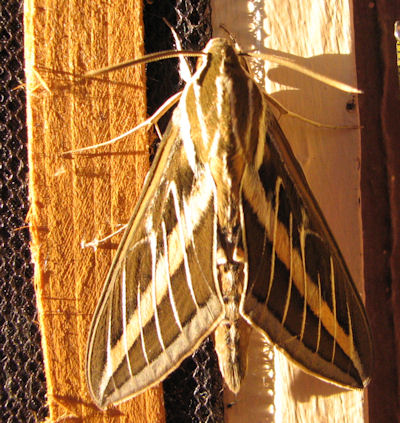
|
| This is the Achemon Sphinx moth, Eumorpha achemon.
See
www.silkmoths.bizland.com:80/eachemon.htm.
I found
it still in a cocoon in a flower bed next to my neighbor's Virginia Creeper patch.
I kept it until it left the cocoon, and then took this picture (summer 2007). They prefer to dine on
grape leaves, or wild grape leaves, but the Virgnia Creeper is close enough.
The second picture was taken on 21 July 2008, and the third on 19 July 2009, both in Colorado Springs.
The fourth and fifth pictures were taken on 19 September 2009. It is a large and fat caterpillar,
8 cm in length, same species as the moth above.
This one would be the fourth instar.
It was found crawling across the floor of our garage.
At this stage, they are looking for a place to pupate, usually in the ground or under leaves.
Kingdom: Animalia
Phylum: Arthropoda
Class: Insecta
Order: Lepidoptera
Family: Sphingidae
Genus: Eumorpha
Species: E. achemon
| 
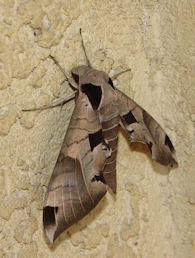
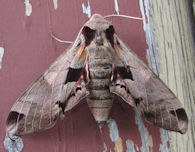
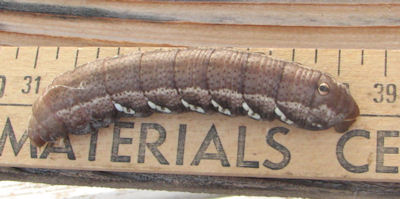
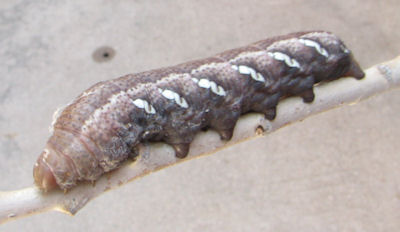
|
| This one was found on 25 June 2010 in Colorado Springs, Colorado, somewhat hidden on a
fence post. It is 2.25" in length. The good folks on www.BugGuide.net identified it for me, as a
Ello Sphinx moth. This moth does normally not come as far north as Colorado.
Kingdom: Animalia
Phylum: Arthropoda
Class: Insecta
Order: Lepidoptera
Family: Sphingidae
Subfamily: Macroglossinae
Genus: Erinnyis
Species: E. ello
| 
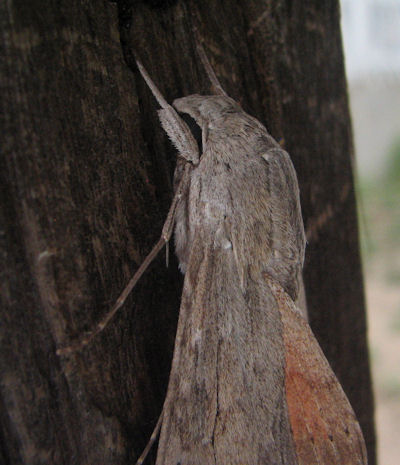
|
| This is a Waved Sphinx moth.
They are strictly nocturnal, and normally hide as dawn approaches.
The small light I left on at my back garage door fooled this one.
This one is medium sized, maybe 18 mm.
It was found on 20 June 2010.
Kingdom: Animalia
Phylum: Arthropoda
Class: Insecta
Order: Lepidoptera
(unranked): Macrolepidoptera
Superfamily: Bombycoidea
Family: Sphingidae
Subfamily: Sphinginae
Genus: Ceratomia
Species: C. undulosa
| 
|
| This is a Blinded Sphinx moth. It was photographed on
16 June 2012 in Colorado Springs, CO. Body length is 4cm. After being in
the McDonald's Sundae lid for a while, I found some small ( 1mm ) green objects,
presumably eggs. Identification was by the experts on www.Bugguide.net.
Kingdom: Animalia
Phylum: Arthropoda
Class: Insecta
Order: Lepidoptera
Family: Sphingidae
Genus: Paonias
Species: P. excaecatus
| 
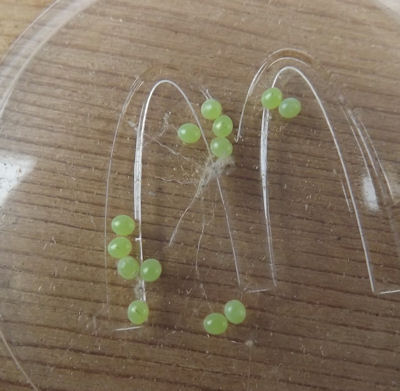
|
| A few days after hatching. They are still taking nourishment from the
eggs. The second picture has a variety of ages since hatching. They have grown horns. Once the egg has
been emptied of nourishment, it is discarded.
| 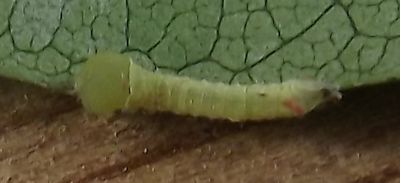
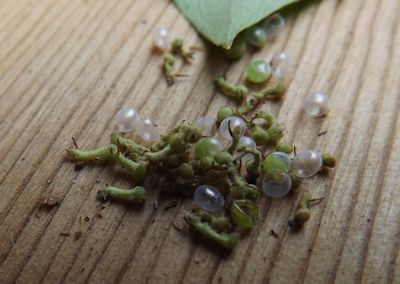
|
| This moth in the Cucullia genus, a Hooded Owlet, was found on the
back wall of my house on 29 June 2009, near a small light which is on 24/7.
It is about 2 cm long. It is either a Cucullia umbratica or
a Cucullia antipoda. These are the names found on two different photos that look identical to
this insect.
Kingdom Animalia (Animals)
Phylum Arthropoda (Arthropods)
Class Insecta (Insects)
Order Lepidoptera (Butterflies and Moths)
No Taxon (Moths)
Superfamily Noctuoidea
Family Noctuidae (Owlet Moths)
Subfamily Cuculliinae
Genus Cucullia (Hooded Owlets)
| 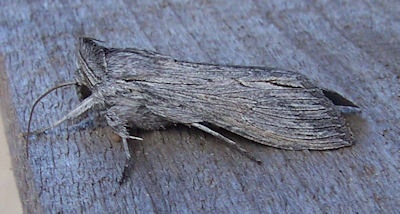


|
| This appears to be a moth named the Soybean Looper
or Cabbage Looper, also called a Ni moth. This one was 2 cm long.
Found 9 November 2008 in Colorado Springs. (This also looks just about like
the Gray Looper Moth, next picture. Maybe an identification problem.)
Kingdom Animalia -- animals
Phylum Arthropoda -- arthropods
Class Insecta -- insects
Order Lepidoptera -- butterflies, moths
Family Noctuidae -- cutworms, dagger moths, noctuid moths, owlet moths
Subfamily Plusiinae
Tribe Argyrogrammatini
Genus Trichoplusia
Species Trichoplusia ni -- cabbage looper
| 
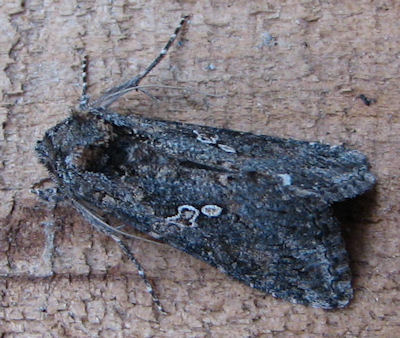
|
| This one is a Gray Looper Moth - Rachiplusia ou.
Found in Colorado Springs on 5 July 2009.
Kingdom Animalia -- animals
Phylum Arthropoda -- arthropods
Class Insecta -- insects
Order Lepidoptera -- butterflies, moths
Family: Owlet Moths, Miller Moths (Noctuidae)
Subfamily: Plusiines (Plusiinae)
Tribe: Plusiini
Subtribe: Autoplusiina
Genus: Rachiplusia
Species: R. ou
|
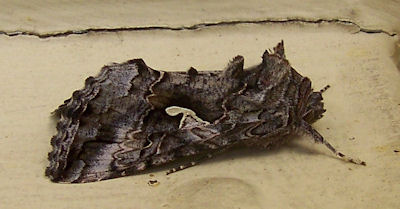
|
| This looks like another Gray Looper. Found in my Marigold patch
on October 6, 2017.
|
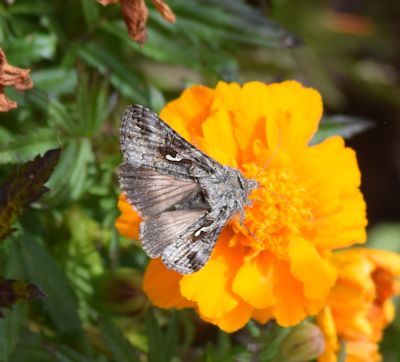
|
| Another moth, photographed on 11 April 2012 in Colorado Springs.
About 1.5 cm body length. The experts on
www.Bugguide.net identified it for me,
as a Celery Looper, Hodges 8924.
The third photo is the same species, on 21 May 2012, also Colorado Springs.
Kingdom: Animalia
Phylum: Arthropoda
Class: Insecta
Order: Lepidoptera
Family: Noctuidae
Genus: Anagrapha
Species: A. falcifera
|
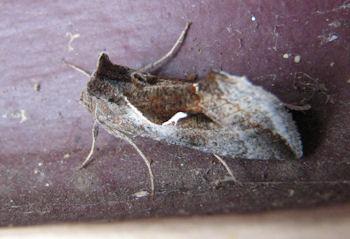
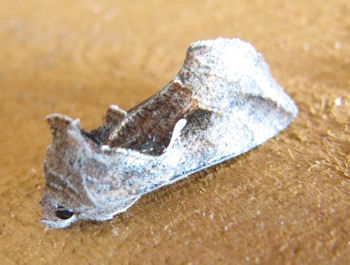

|
| This caterpillar is an American Dagger Caterpillar. It will turn into
the adult form of American Dagger Moth, named for the dagger-like markings on it's wings.
It was photographed
on 14 September 2009, under a large Maple tree in Colorado Springs, Colorado.
It was about 1.5 inches in length.
Kingdom: Animalia
Phylum: Arthropoda
Class: Insecta
Order: Lepidoptera
Family: Noctuidae
Subfamily: Acronictinae
Genus: Acronicta
Species: americana
| 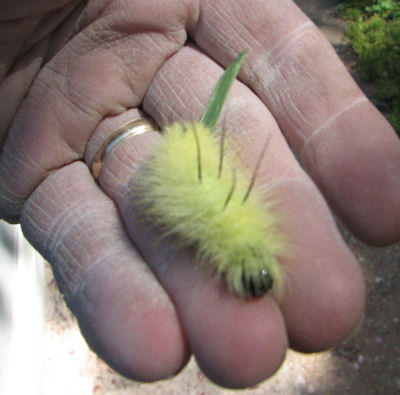
|
| This is an immature Army Cutworm. The picture was taken on June 4, 2008,
next to the young Gladiola plant that it had cut off. The adult of this species is called
a Miller Moth.
Kingdom: Animalia
Phylum: Arthropoda
Class: Insecta
Order: Lepidoptera
Family: Noctuidae
Subfamily: Noctuinae
Tribe: Agrotini
Genus: Euxoa
Species: E. auxiliaris
| 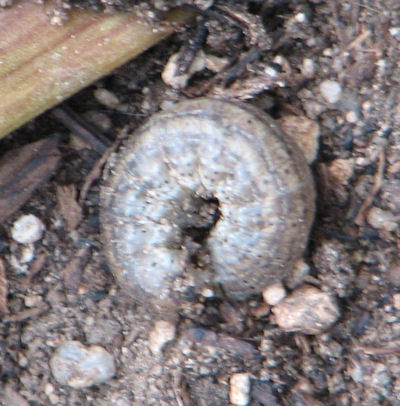
|
These are Miller Moths, Euxoa auxiliaris.
In early summer, they leave the plains east
of Colorado Springs and head for the mountains to escape the heat.
They always stop by everyone's house in Colorado Springs for a while.
Then, in late summer and early fall, they stop by again on their way back
to the plains east of here. Actually, they are the army cutworm, Euxoa auxiliaris.
See
www.extension.colostate.edu/4DMG/Pests/millers.htm.
The second picture was taken on 30 April 2009 in Elbert co., CO. I thought that this
would be a little too early for them, but I guess not.
| 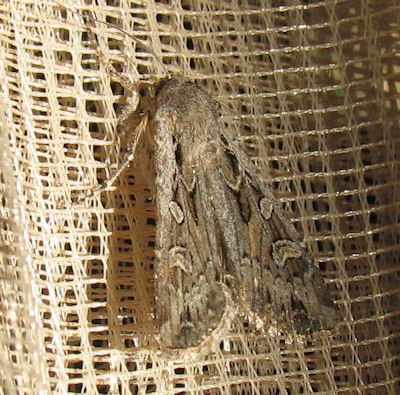
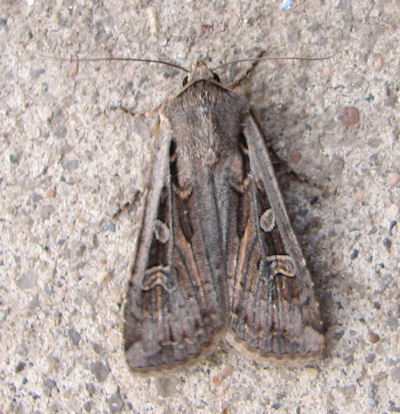
|
| This is a Large Yellow Underwing moth,
found on 24 September 2010 in Colorado Springs.
Body length was at least 1".
Kingdom: Animalia
Phylum: Arthropoda
Class: Insecta
Order: Lepidoptera
Family: Noctuidae
Genus: Noctua
Species: N. pronuba
| 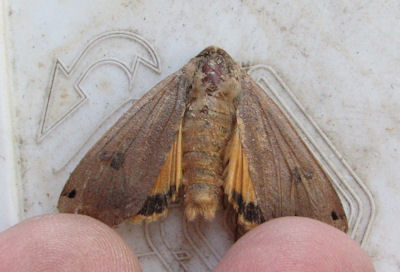
|
| This one is another Underwing moth,
found on 6 October 2010 in Colorado Springs. It was about 1 1/4" body length.
Maybe it is the Sleepy Underwing Moth, but there are many species in the same genus.
The color was not as blue as this picture shows; it was more gray.
The second picture shows the correct color.
Kingdom: Animalia
Phylum: Arthropoda
Class: Insecta
Order: Lepidoptera
Superfamily: Noctuoidea
Family: Noctuidae
Genus: Catocala
Species: C. concumbens
| 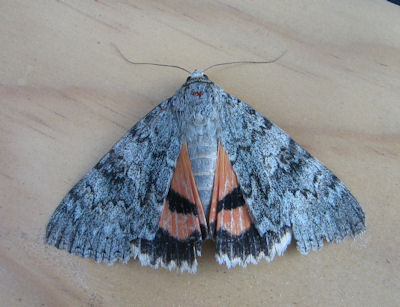
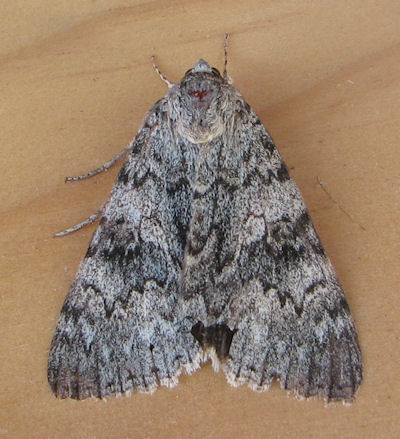
|
| This is probably a Yellow-Three Spot, Apamea Helva.
It was about 2.3cm long. September 3, 2008 in El Paso County, CO.
Kingdom: Animalia
Phylum: Arthropoda
Class: Insecta
Order: Lepidoptera
Family: Noctuidae
Genus: Apamea
Species: Helva
| 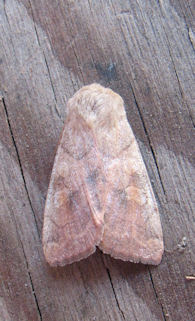

|
| This moth is unknown, but there are some similarities to the shape and
some features to the Yellow-Three Spot moth above, so it is probably in the same
family.
It was found on 2 April 2011 in Colorado Springs. It was the first warm day we
had, so some insects are up and about. It was 2 cm in body length.
| 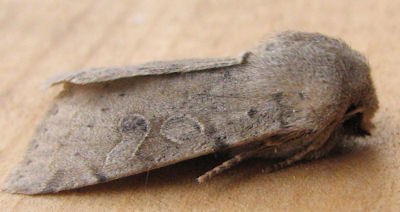

|
Another small unidentified moth, found 8 July 2009 in Colorado Springs.
It is about 9mm in length. It is similar to a Yellow-spotted Renia Moth, Renia flavipunctalis.
Kingdom: Animalia
Phylum: Arthropoda
Class: Insecta
Order: Lepidoptera
Family: Noctuidae
| 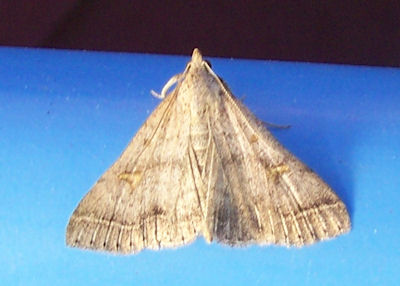
|
| Another small unidentified moth, found 14 July 2009 in Colorado Springs.
It is about 9mm in length. It looks a lot like the moth above, but could still be a different species.
It is similar to a Renia flavipunctalis, so it is probably a member of the Noctuidae family.
Kingdom: Animalia
Phylum: Arthropoda
Class: Insecta
Order: Lepidoptera
Family: Noctuidae
| 
|
| This large moth is called the Black Witch.
It has many other names in Central America and the Carribean.
This one was seen in Colorado Springs, CO on 25 June 2010.
It measured 5 1/4" wing tip to wing tip.
They reproduce in Mexico, but are strong fliers and are sometimes seen in the
Front Range area of Colorado.
Kingdom: Animalia
Phylum: Arthropoda
Class: Insecta
Order: Lepidoptera
Family: Noctuidae
Subfamily: Calpinae
Genus: Ascalapha
Species: A. odorata
| 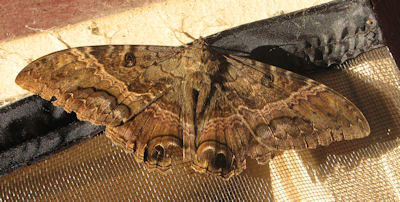
|
| This one was found on 26 June 2011 in Colorado Springs, CO.
Body length is about 1 cm. It is a Pink-barred Pseudeustrotia.
Identification provided by Corey Husic on www.bugguide.net.
Kingdom Animalia (Animals)
Phylum Arthropoda (Arthropods)
Class Insecta (Insects)
Order Lepidoptera (Butterflies and Moths)
Superfamily Noctuoidea
Family Noctuidae (Owlet Moths)
Subfamily Noctuinae (Cutworm or Dart Moths)
Tribe Pseudeustrotiini
Genus Pseudeustrotia
Species carneola (Pink-barred Pseudeustrotia - Hodges#9053
| 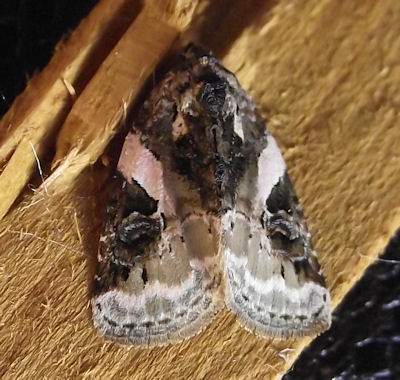
|
This is a Confused Dart Moth.
It is about 1.3 cm in length. Found on 20 September 2009 in Colorado Springs.
Identified for me by Sam Bailey on 26 November 2011.
mothphotographersgroup.msstate.edu/species.php?hodges=10675 .
Kingdom: Animalia
Phylum: Arthropoda
Class: Insecta
Order: Lepidoptera
Family: Noctuidae
Genus: Feltia
Species: F. tricosa
| 
|
| This moth was photographed on
18 July 2013 in Colorado Springs, CO. Body length about 1cm.
Bob Patterson on www.Bugguide.net identified it as a Raphia frater, The Brother.
Kingdom: Animalia
Phylum: Arthropoda
Subphylum: Hexapoda
Class: Insecta
Order: Lepidoptera
Family: Noctuidae
Genus: Raphia
Species: R. frater
| 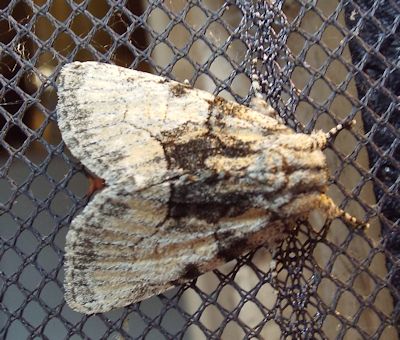
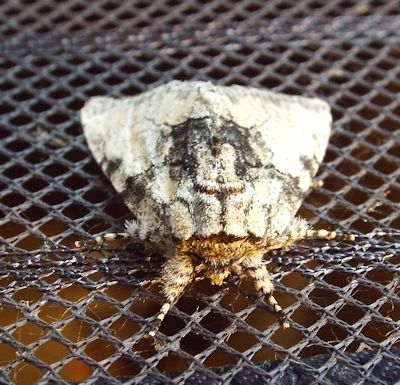
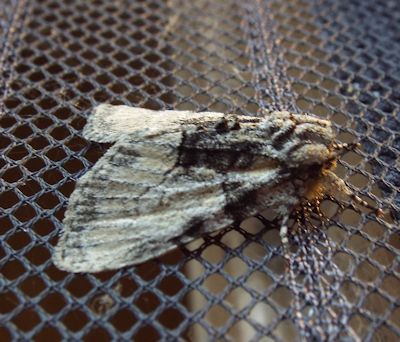
|
| A small, unidentified moth.
It was about 1.3 cm long.
September 3, 2008 in El Paso County, CO.
| 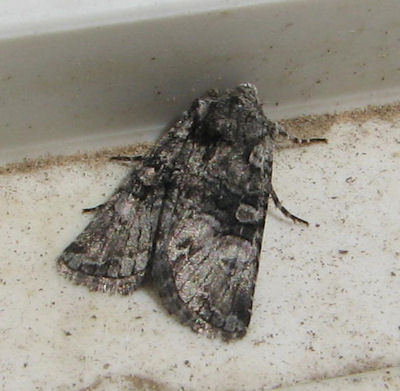
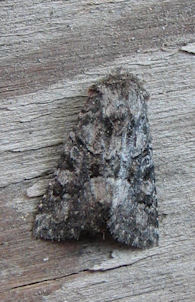
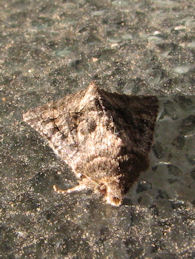
|
| This moth is about 1.5 cm, and was found on 19 May 2009. It appears very similar to
the ones shown above.
The second pictures shows another one, seems to be identical, found in Colorado Springs on 9 June 2010.
| 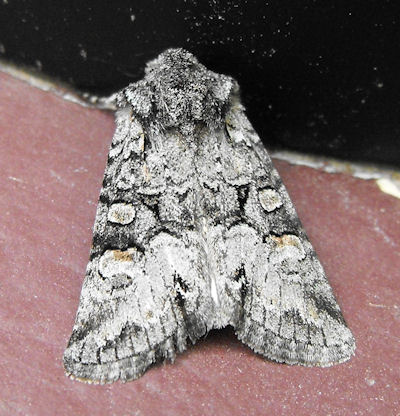
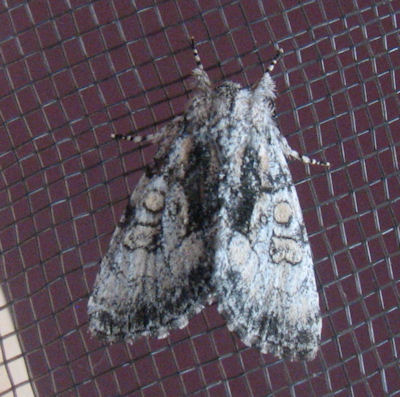
|
| Another small unidentified moth, found 11 July 2009 in Colorado Springs.
It is about 1.4cm in length. This is probably the same species as the moth above.
The second picture was taken on 15 August 2009, Colorado Springs.
The third picture seems to be the same species, and was taken on 20 July 2010, same location. This
one was about 10mm in length. It was avoiding the rain.
| 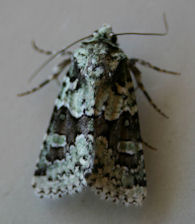

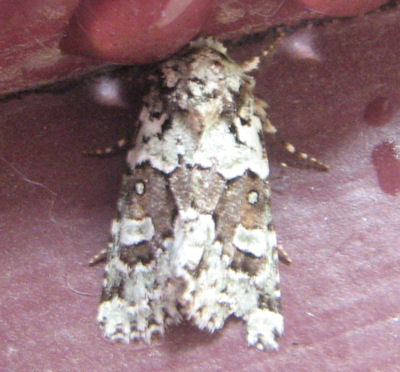
|
| A small unidentified moth, found 20 September 2009 in Colorado Springs.
It is about 1.3 cm in length.
| 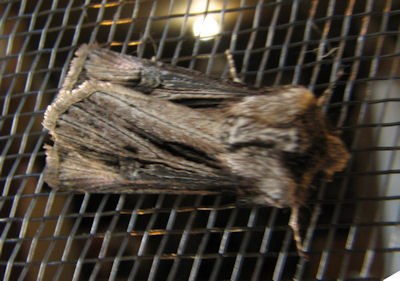
|
| A small unidentified moth, found 8 July 2009 in Colorado Springs.
It is about 9mm in length.
The second picture is another one, found 17 July 2009.
The third picture was taken on 10 July 2010, same location, same species.
| 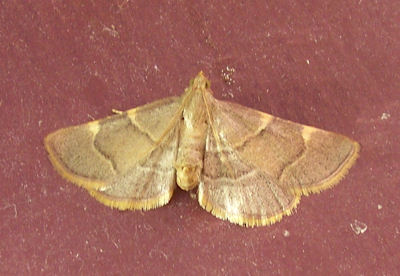
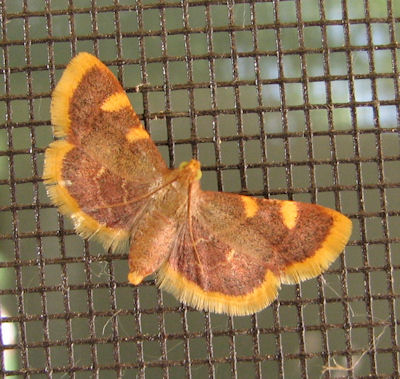
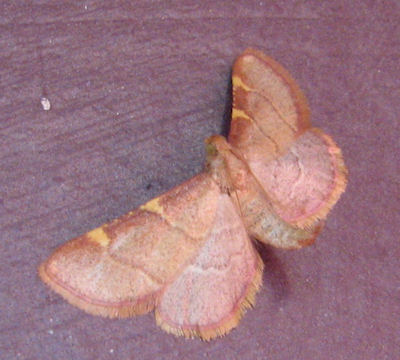
|
| Another small unidentified moth, found 11 July 2009 in Colorado Springs.
It is about 1.3 cm in length. It looks a lot like the moth in the picture above, except
for the different color.
| 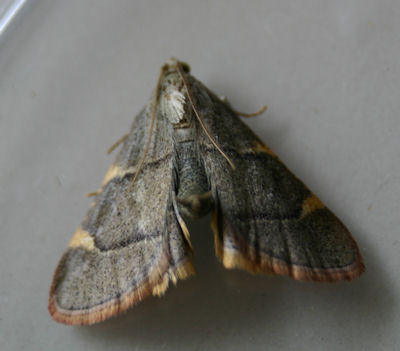
|
| Another small unidentified moth, found 14 May 2010 in Colorado Springs.
It is about 1.7 cm in length.
| 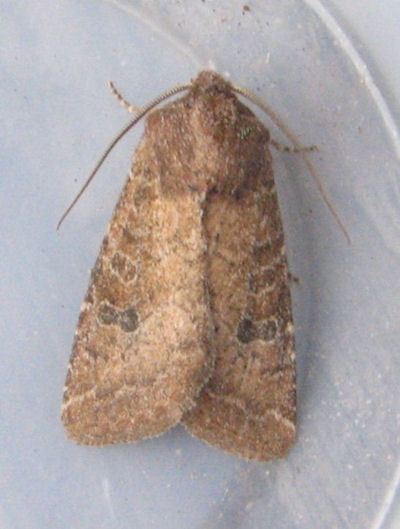
|
| Another small unidentified moth, found 16 September 2009 in Colorado Springs.
It is about 1.5 cm in length.
| 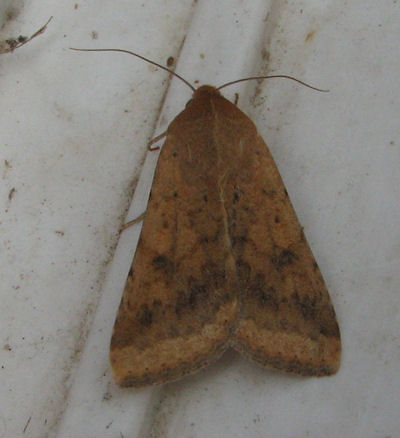
|
| Another small unidentified moth, found 16 September 2009 in Colorado Springs.
It is about 1.5 cm in length.
| 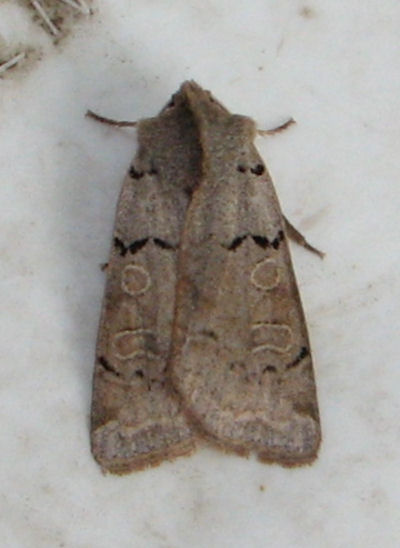
|
| Another small unidentified moth, found 16 September 2009 in Colorado Springs.
It is about 1.5 cm in length.
| 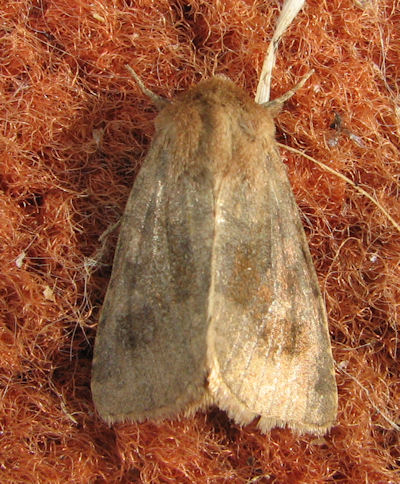
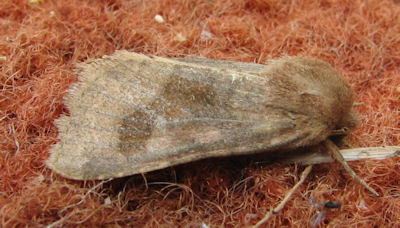
|
| Don't know what will come out of this 2 cm pupua, but I will
try to keep track of it and see what happens. It is probably a moth. This picture was
taken on 30 April 2010 in Colorado Springs. (I think it died -- finally threw it out)
| 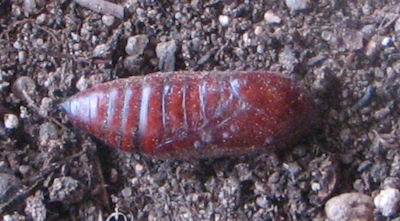
|
| This caterpillar was crawling on my garage floor on 24 September 2012.
It was about 3cm in length. No identification has been made yet, but it would be some
butterfly or moth.
| 
|
| Another small unidentified moth,
found 2 August 2009 in Colorado Springs.
It is about 9mm in length.
The second one was found on 20 August 2010, same place. One wing is torn.
| 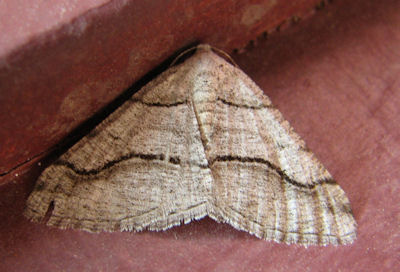

|
| Another small unidentified moth, found 10 July 2009 in Colorado Springs.
It is about 6 mm in length.
| 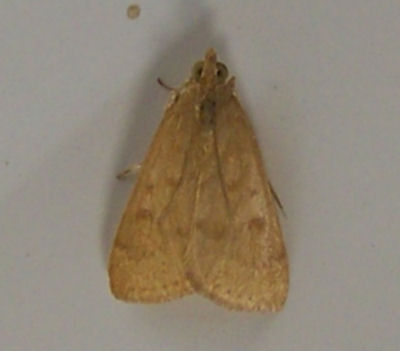
|
| This one resembles photos of Slug moths found on the internet, but no exact matches.
It was photographed on 20 September 2009 in Colorado Springs, CO.
Some photos at
www.pbase.com/tmurray74/prepyralid_moths show similar moths.
Kingdom Animalia (Animals)
Phylum Arthropoda (Arthropods)
Class Insecta (Insects)
Order Lepidoptera (Butterflies and Moths)
No Taxon (Moths)
Superfamily Zygaenoidea
Family Limacodidae (Slug Caterpillar Moths)
|
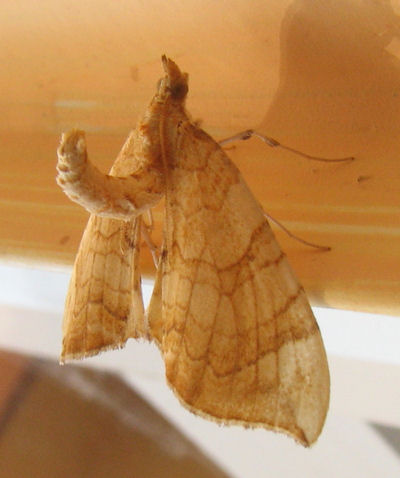
|
| Another small unidentified moth, found 23 July 2009 in Colorado Springs.
It is about 1 cm in length.
| 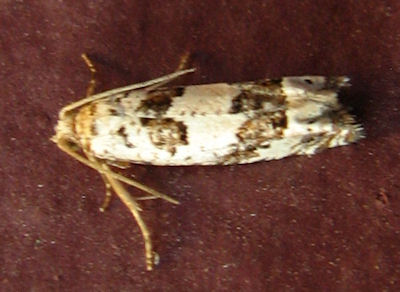
|
| Another small unidentified moth, found 11 July 2009 in Colorado Springs.
It is about 1.1 cm in length.
| 
|
| Another small unidentified moth, found 16 July 2009 in Colorado Springs.
It is 1.1 cm in length.
| 
|
| Another small unidentified moth, found 19 July 2009 in Colorado Springs.
It is about 1 cm in length.
| 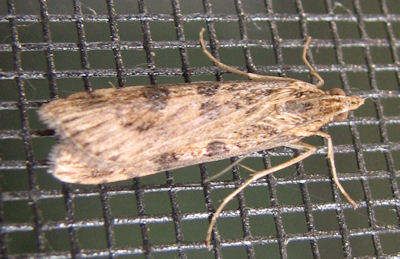
|
| Another small unidentified moth, found 7 August 2009 in Colorado Springs.
It is about 1.5 cm in length.
| 
|
| Another small unidentified moth, found 5 August 2009 in Colorado Springs.
It is about 1.5 cm in length. It looks a little like an owlet or looper.
| 
|
| Another one, same species as the above,
found in Colorado Springs on 21 August 2011.
| 
|
| This small moth rested for two days on the back wall of my house,
near a small light which was on 24/7. This picture was taken on 31 May 2009.
Identification is pending.
| 
|
| This one was photographed on 9 July 2010 in Colorado Springs, CO.
Identification is pending.
| 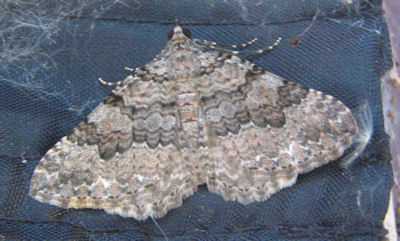
|
| This one was found on 8 April 2011 in Colorado Springs, CO.
The blue areas in the picture is due to my camera. The moth didn't have any blue showing.
Identification is pending.
| 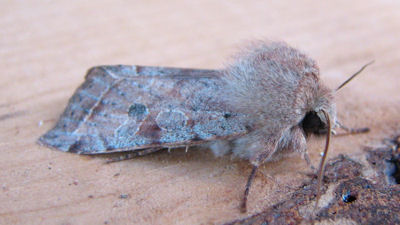
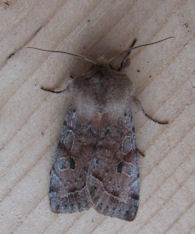
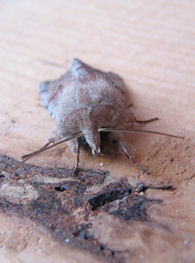
|
| This small moth was photographed on 17 August
2011 in Colorado Springs, CO.
Identification is pending.
| 
|
| This small moth was photographed on
5 October 2011 in Colorado Springs, CO.
Identification is pending.
| 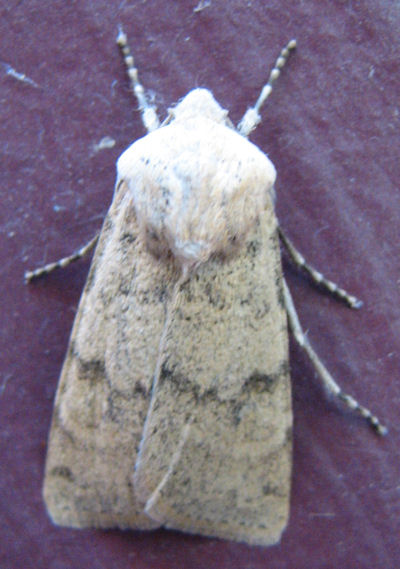
|
| This small moth was photographed on
5 October 2011 in Colorado Springs, CO.
Identification is pending.
| 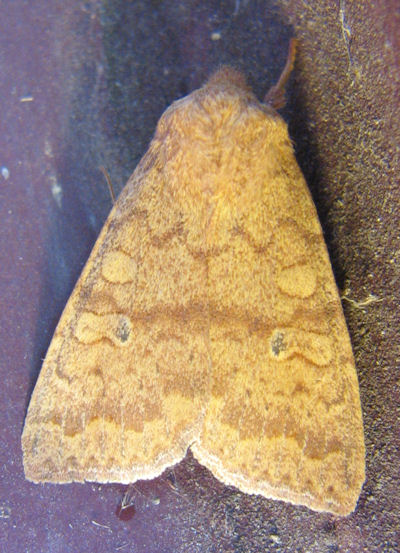
|
| This moth was photographed on
13 October 2011 in Colorado Springs, CO.
Identification is pending.
| 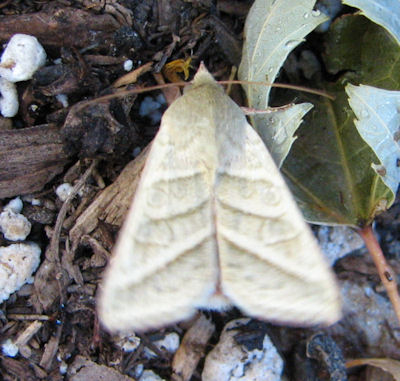
|























